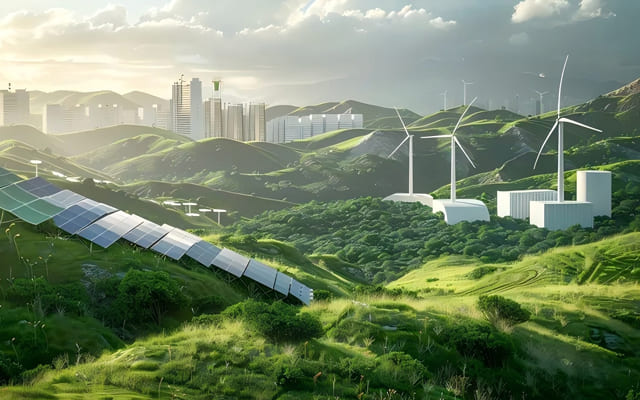What Are MW and MWh? A Simple Guide to Understanding Power and Energy in Wind, Solar, and Storage Projects
In the world of renewable energy—especially in wind, solar, and energy storage systems—you’ll often come across technical units like W, kW, MW, MWh, Wh, and GW.
At first glance, these units may seem confusing to those unfamiliar with the energy industry. So, what do they actually mean? How are MW and MWh different? And how do they work together in real-world applications? Let’s break it down.
1. Power Units: W, kW, MW, and GW – How Fast Energy Flows
Let’s begin with power, which refers to the rate at which energy is generated or consumed at any given moment.
-
1 kW = 1,000 watts (W)
-
1 MW = 1,000 kW = 1,000,000 W
-
1 GW = 1,000 MW
In other words, power measures speed—how fast energy is being delivered.
For instance, a wind turbine rated at 10kW can theoretically produce 10 kilowatt-hours (kWh) of electricity in one hour under optimal wind conditions.
Think of power (MW) like a car’s horsepower: the higher the number, the faster it can respond. However, speed alone doesn’t tell you how far it can go—that’s where energy capacity comes in.
2. Energy Units: Wh, kWh, MWh – How Long Energy Lasts
While power tells you how fast energy flows, energy units like Wh, kWh, and MWh tell you how much energy is stored or consumed over time.
-
1 kWh = 1,000 Wh
-
1 MWh = 1,000 kWh = 1,000,000 Wh
In contrast to power, energy determines how long the system can operate.
✅ Example:
A battery labeled 50MW/100MWh means it can discharge power at 50MW for 2 hours. Alternatively, it could run at 25MW for 4 hours.
So, if MW is your vehicle’s speed, then MWh is the size of its fuel tank. The larger the tank, the farther it can go.
3. The Relationship Between MW and MWh: Power × Time = Energy
Here’s a simple yet essential formula:
Energy (MWh) = Power (MW) × Time (hours)
For example:
-
A 2MW system operating for 3 hours = 2MW × 3h = 6MWh of energy output.
-
Similarly, to supply 200MWh over 2 hours, the system must have at least 100MW of power capacity.
Therefore, when you see a configuration like 60MW/120MWh, it means the system can sustain full output for 2 hours. This balance between power and duration is critical in energy storage design.
4. How MW and MWh Work in Different Renewable Systems
Let’s look at how these units apply across solar, wind, and battery projects:
| Application | Unit Used | What It Describes |
|---|---|---|
| Solar/Wind Power Plant | MW | Installed generation capacity |
| Annual Output | MWh | Total yearly energy production |
| Energy Storage | MW/MWh | MW = power rate, MWh = duration |
| Frequency Regulation | MW | Fast, short bursts of power |
| Emergency Backup | MWh | Focus on long-duration power supply |
As you can see, each unit serves a specific purpose. While MW supports high-demand, fast-response needs, MWh supports long-duration applications like backup or peak shaving.
5. Real-World Use Cases
🔸 Solar Plant Example
Suppose you operate a 10MW solar farm, and the region has 1,400 effective sunlight hours annually.
Then, your annual generation is:10MW × 1,400h = 14,000MWh of energy—or 14 million kWh (units of electricity).
🔸 Storage Matching Rule: 20%, 2-Hour
If a solar farm is 10MW, and the rule says “20% storage, 2 hours,” you would need a 2MW/4MWh battery system to match.
🔸 Storage Cost Example
Storage is often priced per Wh.
If the cost is RMB 0.75/Wh, then a 4MWh system costs:4,000,000Wh × 0.75 = RMB 3 million
6. MW and MWh in Small Wind Turbine Applications
At ELEGE New Energy, our small wind turbines (300W to 50kW) often come with battery options. For example:
-
Our EL-H3-3000W turbine can generate up to 3kWh per hour.
-
Paired with a 5kWh battery, it can store power during the day and supply it during the night.
This flexibility is ideal for off-grid homes, farms, or hybrid wind-solar systems.
7. Summary: Know the Difference and Use Both Wisely
Let’s recap the core difference:
| Unit | Measures | Determines |
|---|---|---|
| MW | Power | How fast energy is delivered |
| MWh | Energy | How long energy lasts |
✅ In summary:
MW = speed, MWh = endurance.
Both are essential for smart energy design.
Whether you’re sizing a small off-grid system or developing a utility-scale project, understanding both MW and MWh is critical for performance, reliability, and profitability.
📌 Learn More About ELEGE Wind Turbine Solutions
We offer wind turbine systems from 500W to 50kW, designed for:
-
Remote homes and cabins
-
Small farms and ranches
-
Emergency backup power
-
Off-grid and hybrid solar-wind setups
🔋 Energy storage options available
🌍 Global shipping and custom configurations
📧 Contact us at: elege@elege.net
🔗 Visit our site:https://elege-energy.com/

